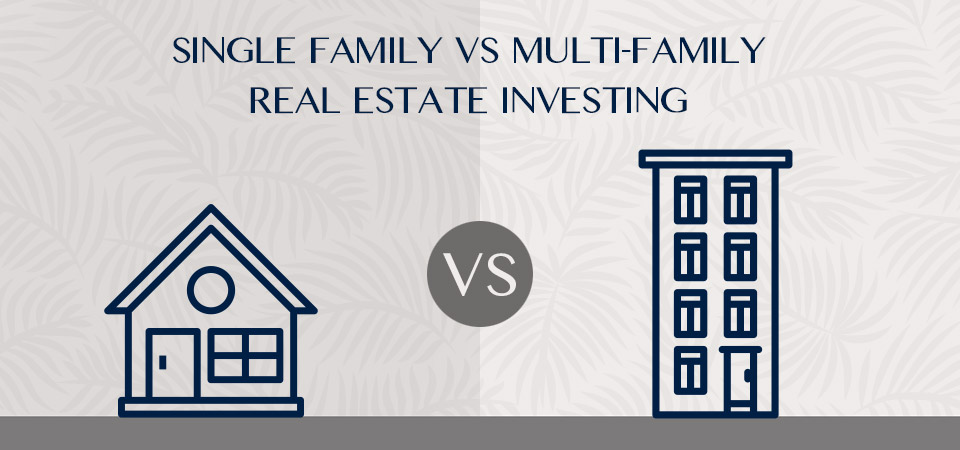- By
- 0 Comments
The soaring interest rates and a strong forecast around the impending recession have
multifamily investors questioning if multifamily investments are still the right choice in
2023.
Before we delve deep into this topic, it is important to understand the factors that drive
the valuation of single family homes and multifamily apartments.
While both these asset classes feel the impact of market volatility, there is one way
Multifamily investments differ significantly from single family homes, and this factor
helps the syndication/investment team exercise control on multifamily valuation.
Continue reading to find more.

Single-Family Homes
The valuation of SFH (Single Family Homes) is almost always calculated
based on the “Market Approach”. This means that the value of such a
property is based on the value of comparable properties, within half a mile
radius, or a mile radius, or the same neighborhood of the subject property,
in the previous six to twelve months. The price of that individual single-
family home is then adjusted up or down, based on the amenities and the
features of the subject property.
This makes the value of a single-family home inextricably linked to the
value of similar properties in and around the location of the property being
considered as ‘Comparables’ during appraisals, tying it to the market itself.
What this means for a potential investor is that the price of the SFH they
might be looking to invest in goes up or down based on the market or quite
simply the properties sold in the surrounding area in the last few months.
Multi Family Homes
On the other hand, the value of a Multifamily Home is calculated based on
the "Income Approach". Being a Commercial Real Estate, think about
multifamily as a business, the higher the net operating income the higher
will it be valued when ready to sell.
Market Value = NOI (Net Operating Income) / Cap Rate.
While the CAP rate is the market identifier, the same property can be
valued for more, even if the CAP rate stays the same, which does not
typically happen in a Single-Family home.
It is important to understand the role of Forced Appreciation here, and how
we can push the value up for the same property.
Forced Appreciation
Forced appreciation is forcing a property value to go up, even if the market
around it hasn't changed much. Yes, this is possible for one of the primary
and most important distinctions between a single-family home, and a
commercial real estate like multifamily.
If you have two multifamily apartment complexes which are very similar,
right across the street from each other, they can still have very different
valuations based on their income stream. The banks value apartment
complexes based on their Net Operating Income which is the Total Income
minus the Expenses before the debt service is paid to the bank (Principal
and Interest payment)
As we saw, the formula for calculating the value of a multifamily property
is:-
Market Value= NOI (Net Operating Income) / Cap Rate.
Let’s try and understand this with the help of an example. Suppose that the
price of a multifamily property is $10 million and the downpayment of $2
million with the rest of the money coming from the bank in the form of
leverage to the tune of $8 million. (The $2 million here is collective equity
coming together from passive investors like you in small chunks)
Now let’s assume that the baseline income from that property is $1.4
million and the expenses are $400,000 during the time of purchasing it as
an investment which brings the
NOI(Income-Expenses) to $1.4 million – $400,000 = $1 million
(Without debt service).
The CAP Rate (NOI/Property Value) therefore comes to
$1 million/$10 million = 10% (now, we don’t live in the world of 10 CAP in
2022, but remember this is just an example for simplicity)
To force appreciation, that is to forcefully increase the value of the
property, the syndication team achieves this by increasing the income
needs AND decreasing the expenses. There are multiple ways of doing so.
For example, you can increase the rent based on inflation, add new
facilities or services like laundry or even paid parking spots and all of this
brings the NOI up.
The most favorable and win-win situation for both investors and tenants is
a value-add, in simple terms, doing the flip of apartment after apartment
and bumping the rent, making it a better place to live for tenants and
adding to NOI for the investment.
Going back to our example, let’s suppose that the income goes up by
$100,000
(Which is just an $84 rent bump, for a 100-unit apartment complex for a
year)
and at the same time, the expenses go down by $100,000, again reducing
$84 expense per unit for the same 100-unit complex for the year
Let’s calculate our new NOI
NOI = Income – Expense = ($1.5 million – $300,000) = $1.2 million.
Let’s say the market did not move at all during this time, and the CAP rate
is the same at 10%
Now applying the formula to calculate Market Value
(NOI/Cap Rate), we get:
$1.2 million/10% = $12 million, which is the new value of the property.
Say we achieve this over 5 years, and while this seems just a 20% growth
Remember the investors collectively contributed just $2 million originally
this is a 2 X multiple for their initial investment, from $2M to $4M or an
increase of 200%!
The CAP rate increase/ expansion does negatively impact the multifamily
values. Increasing Net Operating Income may balance this value, but in a
recessionary environment one has to trade carefully.

The Verdict
We can therefore see that Multifamily real estate is not directly affected by
the vagaries of the market as much as Single Family housing, however the
CAP rate increase will impact the values negatively. Historically, during
market cycles/recessions, multifamily housing has been shown to retain its
occupancy and rent growth. Even during the 2008 crisis and the COVID-19
pandemic, the statistics indicate this asset class retained its value.
Whether it was 2008 or the pandemic shelter remained a need and the
multifamily assets held up their value robustly. During 2022-2023 rapid
interest rate hikes have impacted the housing market overall. With prices
going down for both single family as well as multi family housing, more
opportunities are expected in the market.
Are you interested in learning more about multifamily, especially the
data/statistics that support this asset class and make a better investment
vehicle for you?


